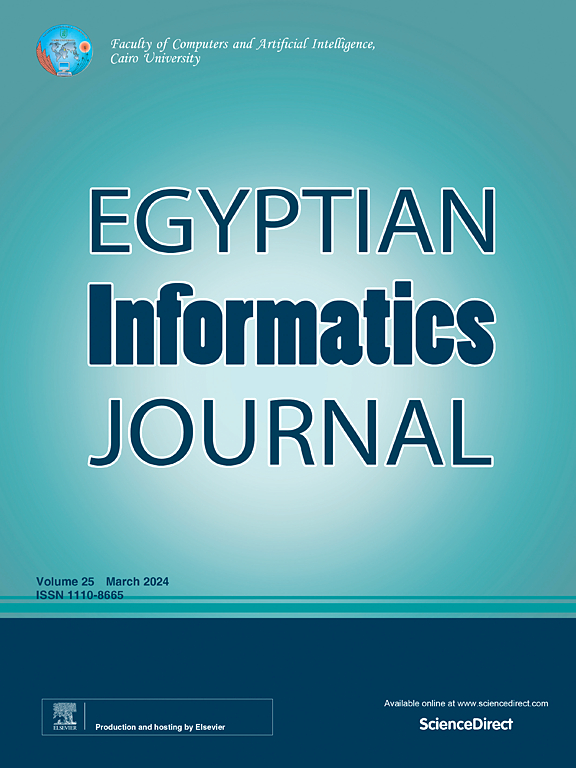可持续农业的深度学习:自动化水稻和水稻成熟度分类,以增强粮食安全
IF 4.3
3区 计算机科学
Q1 COMPUTER SCIENCE, ARTIFICIAL INTELLIGENCE
引用次数: 0
摘要
准确和及时的水稻成熟度分类对于优化收获决策、提高粮食质量和加强全球粮食安全至关重要。传统的手工评估仍然是主观的,劳动密集型的,并且缺乏可伸缩性,强调了对自动化解决方案的需求。本研究对五种用于实时水稻成熟度评估的微调深度学习架构进行了严格的比较评估:增强了注意力引导多尺度特征融合(AGMS-FF)模块的YOLOv11、基线YOLOv11、ResNet18、EfficientNet-B0和MobileNetV3。使用了两个公开可用的数据集:一个用于模拟不同的现场条件,另一个包含原始的、不受控制的图像,以评估现实世界的普遍性。为了确保稳健性和减轻过拟合,我们采用了5倍交叉验证和持续测试评估。通过准确性、精密度、召回率、f1评分、ROC-AUC和PR-AUC指标对模型进行评估。AGMS-FF YOLOv11在增强数据集上的交叉验证精度高达99.6%(±0.21),ROC-AUC = 0.9877, PR-AUC = 0.9526;在原始数据集上的测试精度为98.0%,ROC-AUC和PR-AUC(1.000)完美。统计验证通过方差分析(Dataset 1: F(4,20) = 158.4, p < 0.001;数据集2:F(4,20) = 92.7, p < 0.001)和McNemar配对检验(p < 0.05)。这些发现为轻量级和最先进的模型提供了强有力的比较基准,加强了基于深度学习的计算机视觉系统在可持续水稻种植中的可行性及其可扩展的田间部署潜力。本文章由计算机程序翻译,如有差异,请以英文原文为准。
Deep learning for sustainable agriculture: automating rice and paddy ripeness classification for enhanced food security
Accurate and timely classification of rice paddy ripeness is critical for optimizing harvest decisions, improving grain quality, and strengthening global food security. Traditional manual assessments remain subjective, labor-intensive, and poorly scalable, underscoring the need for automated solutions. This study presents a rigorous comparative evaluation of five fine-tuned deep learning architectures for real-time rice maturity assessment: YOLOv11 enhanced with an Attention-Guided Multi-Scale Feature Fusion (AGMS-FF) module, baseline YOLOv11, ResNet18, EfficientNet-B0, and MobileNetV3. Two publicly available datasets were utilized: one augmented to simulate diverse field conditions and another comprising raw, uncontrolled imagery to assess real-world generalizability. To ensure robustness and mitigate overfitting, we employed 5-fold cross-validation alongside a held-out test evaluation. Models were assessed across Accuracy, Precision, Recall, F1-score, ROC-AUC, and PR-AUC metrics. The AGMS-FF YOLOv11 achieved superior performance, with up to 99.6 % cross-validation accuracy (±0.21), ROC-AUC = 0.9877 and PR-AUC = 0.9526 on the augmented dataset, and 98.0 % test accuracy with perfect ROC-AUC and PR-AUC (1.000) on the raw dataset. Statistical validation confirmed the significance of these results through ANOVA (Dataset 1: F(4,20) = 158.4, p < 0.001; Dataset 2: F(4,20) = 92.7, p < 0.001) and McNemar’s paired tests (p < 0.05). These findings provide robust comparative benchmarks across lightweight and state-of-the-art models, reinforcing the viability of deep learning-based computer vision systems for sustainable rice farming and their potential for scalable field deployment.
求助全文
通过发布文献求助,成功后即可免费获取论文全文。
去求助
来源期刊

Egyptian Informatics Journal
Decision Sciences-Management Science and Operations Research
CiteScore
11.10
自引率
1.90%
发文量
59
审稿时长
110 days
期刊介绍:
The Egyptian Informatics Journal is published by the Faculty of Computers and Artificial Intelligence, Cairo University. This Journal provides a forum for the state-of-the-art research and development in the fields of computing, including computer sciences, information technologies, information systems, operations research and decision support. Innovative and not-previously-published work in subjects covered by the Journal is encouraged to be submitted, whether from academic, research or commercial sources.
 求助内容:
求助内容: 应助结果提醒方式:
应助结果提醒方式:


